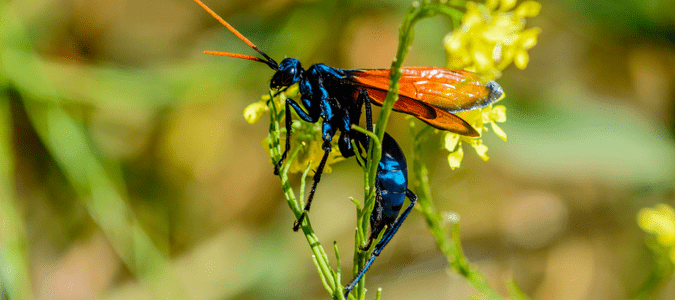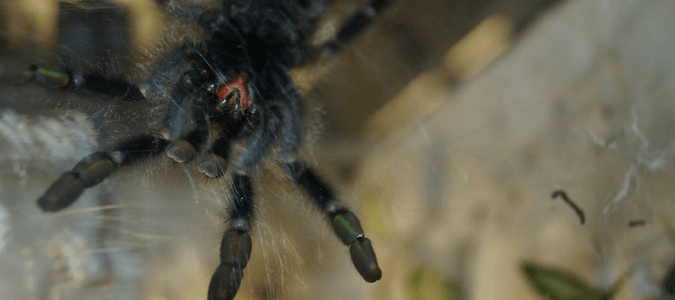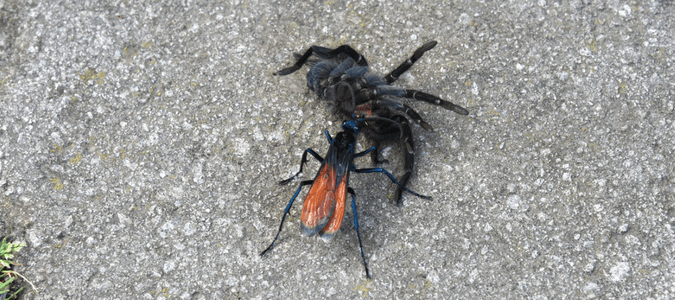
Before we go into detail about the tarantula hawk, let’s make sure one thing is clear: this creature, contrary to what its name might suggest, is not a spider, nor is it a hawk. In fact, the tarantula hawk is one of the largest wasps found in Texas and other desert environments in the southwestern parts of the United States.
If this animal is an insect, how did it get its name? Believe it or not, this type of wasp, which is distinct because of its large size, red wings and bright, metallic blue-black coloring, preys on tarantulas. When this wasp stings a tarantula, the arachnid becomes permanently paralyzed. The tarantula wasp then buries the spider in a hole in the ground or in the tarantula’s own underground nest. To finish the job, the wasp lays its eggs on the paralyzed spider. Once the wasp’s larvae hatch, they feed on the still paralyzed spider. Sounds like a scene out of a horror movie, right?
The process, seen through by the species’ females, sounds rather vicious, but fear not; the tarantula hawk is generally harmless to humans because they rarely sting. Still, though, it’s best to leave them alone, as if a wasp is provoked, you are at a higher risk of being stung. Read on to learn more about the tarantula hawk’s sting, the relationship between a tarantula hawk and a tarantula, where these wasps live and where these creatures nest.

Tarantula Hawk Sting
Similar to bee species, only female wasps sting. For their prey, these stings are deadly. People who are unlucky enough to be stung by a tarantula hawk report that it’s one of the most painful insect stings in the world. Justin Schmidt, an American entomologist, developed a sting pain index and classified the tarantula hawk sting as the most painful wasp sting in the world. The level of discomfort is second only to the South American bullet ant for all stinging insects. The initial pain for a victim of a tarantula hawk sting lasts between three and five minutes.
What does being stung by one of these wasps feel like, exactly? Schmidt says that many victims are unable to “maintain verbal and physical coordination after getting stung” by a tarantula hawk. Though this wasp species can produce an incredibly powerful sting, a female’s stinger is actually quite small, measuring just ¼ of an inch, or 7 mm, in length.
The pain of a tarantula hawk sting has been compared to being hit by a taser gun. Despite its powerful sting and high ranking on the Schmidt sting pain scale, it is unknown what causes a tarantula hawk sting to be so painful to humans.
As much as you should avoid being stung by a tarantula hawk, keep in mind that these creatures are not aggressive, so the chances are very unlikely that you will become a victim.

Tarantula Hawk Vs. Tarantulas
Now that we know more about why this wasp species got its name, you might be wondering why a wasp preys on these huge spiders instead of decaying fruit, nectar or other smaller insects, as other species do. The main reason is simple: the tarantula’s size. For female wasps, the spider’s large size makes it the perfect meal for their offspring, which are known to be larger than most other insects at birth.
The wasp first seeks its prey by searching the ground for spiders from the air. If the wasp notices a spider hidden in its burrow or nest, the female wasp will stroke the spider’s web, causing movement. The tarantula then emerges from its hiding spot to claim its assumed kill. Once the tarantula is exposed, the wasp performs a deadly dance to encourage the tarantula to rear up on its back legs, which allows the tarantula hawk to sting its prey.
What happens next? The tarantula hawk pierces the spider with a sharp, curved stinger that rapidly injects venom that causes permanent paralysis. One thing to note, though, is that the wasp does not kill its prey; instead, the venom keeps its adversary alive. In fact, the spider stays alive even while the wasp lays her eggs and while the eggs hatch. The spider is killed only after the larvae hatch, as that’s when the larvae burrow into the spider’s abdomen and begin eating the tarantula alive.
The development process for the tarantula wasp takes about 20 to 25 days. The eggs will hatch within a few days after being laid, but the larva must undergo multiple phases before becoming an adult, molting its skin four times. During this time, the larva has eaten the spider’s blood, muscle, fat, digestive system and reproductive system—leaving only the heart and nervous system intact. Once the wasp molts for the fifth time, the creature eats the rest of the spider before spinning a silken cocoon to pupate.
The pupal stage depends on the time of year, taking only several weeks in the early season to as long as the entire winter in the later part of the season. After the adult wasp emerges, males have just a few weeks to live. Female wasps, however, can live four to five months. Though both males and females can grow to be as large as five centimeters in length—the largest of the wasp species—as we have already mentioned, only the female wasps have stingers.
The tarantula wasp venom is so powerful that the spider’s death is inevitable; it will die whether or not larvae is present. Because the paralysis is so severe, the spider would remain paralyzed for an extended period of time before its respiratory system eventually stops. If you are talking about tarantulas in Texas or in other parts of the country, in a battle between the tarantula hawk and a tarantula, the latter doesn’t stand a chance.

Where Does The Tarantula Hawk Wasp Live?
Between 250 and 300 species of tarantula hawks are scattered across the planet. These stinging insects are found in just about every continent except Europe and Antartica. There are about 15 species of tarantula hawks and other parts of the country, although they are most commonly found in deserts in the country’s southwest regions. This isn’t shocking, since their prey, tarantulas, are most commonly found in desert-like habitats as well, including in and around the Grand Canyon.
Despite their preference for desert-like environments, this species is incredibly adaptable and is capable of surviving in other environments, including tropical rainforests and shrub and grasslands. Unlike other wasp species, the tarantula wasp doesn’t don’t live in colonies, choosing solitary lives, only coming together to mate.
After learning about how the tarantula hawk got its name, you may be surprised to learn that non-egg laying adult tarantula hawks feeds only on nectar. In other words, they don’t hunt for food. Another interesting fact about this insect is that it is diurnal, which means these wasps are active during the day. Why is this strange? Tarantulas are nocturnal, so when females do hunt their arachnid prey, much of the process occurs at night.
Though they are mainly active during the day, tarantula hawks try to avoid high temperatures as much as possible. As such, when they are outside hunting for prey, they are typically seen flying in the shade under plants and trees.

Is There Such A Thing As A Tarantula Hawk Wasp Nest?
Because this wasp species is not social, tarantula hawks don’t build nests. Instead of a nest, the tarantula hawk instead opts to burrow into the soil or natural spaces in the ground. These stinging insects are also known to make their home in cavities that have already been built out by other insects or animals in the ground. If you are worried that you might accidentally have a close encounter with a tarantula hawk, keep in mind that this species of wasp isn’t naturally aggressive towards humans. So if you do see one near or in your home, it’s best to leave them alone. Chances are, they will leave on their own accord.
Without colonies, the good news is that it is very unlikely that your home or yard will be infested with tarantula hawks. That said, just one sting from one tarantula wasp can be incredibly painful. If you aren’t keen on having stinging insects of any kind on your property, you can take steps to learn what attracts wasps and watch your home’s eaves for a red wasp nest or signs of other species. Some of the same techniques to keep wasps away correspond with how to keep tarantulas away, which of course are prey for reproducing tarantula hawk females: sealing any gaps on your home’s exterior and making sure window frames and doors have no gaps to allow these creatures to come inside or rest.
If you do encounter a large wasp in or around your home, it’s important to stay calm. As we mentioned, this species is not inherently aggressive, and if left alone, will likely exit on its own in search of its prey. If you begin to notice more wasps in and around your home, though, it might be time to call in the experts from your local pest control company.
ABC Can Protect Your Family From Stinging Insects
Because the tarantula wasp maintains an isolated lifestyle, it’s often hard to remove them from your home. In many cases, insect or pest removal techniques depend on a nest or colony to focus on. Without a nest to remove or identify, it can be challenging—and potentially dangerous, or extremely painful in this case—to try to remove individual wasps on your own. That’s where ABC Home and Commercial Services comes in. Our team of experts can distinguish between wasp species and carefully, and cautiously, remove one or many tarantula wasps from your home so that you don’t have to worry about anyone in your household falling victim to a painful sting. Schedule a service today.
